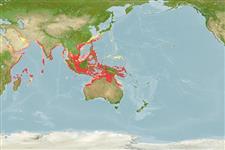Preferred temperature (Réf.
123201): 26.6 - 29.1, mean 28.2 °C (based on 1198 cells).
Phylogenetic diversity index (Réf.
82804): PD
50 = 0.7500 [Uniqueness, from 0.5 = low to 2.0 = high].
Bayesian length-weight: a=0.00676 (0.00510 - 0.00897), b=3.14 (3.06 - 3.22), in cm total length, based on LWR estimates for this species (Ref.
93245).
Niveau trophique (Réf.
69278): 4.4 ±0.3 se; based on diet studies.
Résilience (Réf.
120179): Milieu, temps minimum de doublement de population : 1,4 à 4,4 années (K=0.26-0.5; tm=3-4; Fec=300,000).
Prior r = 0.74, 95% CL = 0.49 - 1.11, Based on 3 data-limited stock assessments.
Fishing Vulnerability (Ref.
59153): Low to moderate vulnerability (29 of 100).
🛈
Climate Vulnerability (Ref.
125649): High to very high vulnerability (68 of 100).
🛈
Nutrients (Ref.
124155): Calcium = 122 [62, 249] mg/100g; Iron = 1.15 [0.54, 2.15] mg/100g; Protein = 18.4 [16.9, 19.9] %; Omega3 = 0.181 [0.080, 0.383] g/100g; Selenium = 68 [30, 151] μg/100g; VitaminA = 20.1 [6.2, 65.2] μg/100g; Zinc = 0.728 [0.470, 1.071] mg/100g (wet weight);
